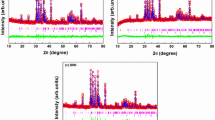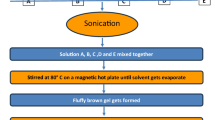Abstract
Measurements of the dielectric susceptibility of a series of lanthanum ethyl sulfate/cerium ethyl sulfate crystals (5–100 at % Ce) have been made over the temperature range 0.05–20 K. The results confirm the Jahn-Teller distortion in pure cerium ethyl sulfate, demonstrate a distortion for up to 25% La in the mixed crystals, and confirm the inversion of the zero-temperature crystal field splitting at about 40% La. The dipole moment of the cerium ion was found to be (5.2±0.4)×10−31 and (6.7±0.5)×10−31 C m for the applied electric field perpendicular and parallel to thec axis, respectively.
Similar content being viewed by others
References
D. R. Taylor, inElectron-Phonon Interactions and Phase Transitions, Tormod Riste, ed. (Plenum, New York, 1977), p. 297.
R. J. Elliott and K. W. H. Stevens,Proc. R. Soc. A 215, 437 (1952).
G. S. Bogle, A. H. Cooke, and S. Whitley,Proc. Phys. Soc. 64, 931 (1951).
D. P. Devor and R. H. Hoskins,Bull. Am. Phys. Soc. 6, 364 (1961).
P. L. Scott and C. D. Jeffries,Phys. Rev. 127, 32 (1962).
J. Van Den Broek and L. C. Van Der Marel,Physica 29, 948 (1963).
A. H. Cooke, S. Whitley, and W. P. Wolf,Proc. Phys. Soc. B 68, 415 (1955).
H. Meyer and P. L. Smith,J. Phys. Chem. Solids 9, 285 (1959).
J. C. Burgiel and H. Meyer,Bull. Am. Phys. Soc. 11, 453 (1966).
C. B. P. Finn and B. M. Najafabadi,J. Phys. C 3, 330 (1970).
J. R. Fletcher and F. W. Sheard,Solid State Commun. 9, 1403 (1971).
R. J. Elliott, R. T. Harley, W. Hayes, and S. R. P. Smith,Proc. R. Soc. A 328, 217 (1972).
D. R. Taylor, D. B. McColl, J. P. Harrison, R. J. Elliott, and L. L. Goncalves,J. Phys. C 10, L407 (1977).
N. E. Topp,The Chemistry of the Rare Earth Elements (Elsevier, 1965), p. 47.
F. M. Jaeger,Rec. Trav. Chem. 33, 342 (1914).
M. W. Nathans,J. Inorg. Nucl. Chem. 22, 231 (1961).
J. T. Folinsbee, J. P. Harrison, D. B. McColl, and D. R. Taylor,J. Phys. C 10, 743 (1977).
I. V. Mitchell and K. M. Barfoot,Nucl. Sci. Appl. 1, 99 (1981).
K. M. Barfoot and R. J. Stubbs, to be published.
R. Cassidy and C. Knight, to be published.
J. P. Harrison, J. P. Hessler, and D. R. Taylor,Phys. Rev. 14, 2979 (1976).
G. A. Gehring, S. J. Swithenby, and M. R. Wells,Solid State Commun. 18, 31 (1976).
D. R. Taylor, private communication.
Author information
Authors and Affiliations
Additional information
Supported by the Natural Sciences and Engineering Research Council and the Queen's University Advisory Research Council.
Rights and permissions
About this article
Cite this article
Stubbs, R.J., Harrison, J.P. Electric susceptibility of mixed cerium/lanthanum ethyl sulfate crystals. J Low Temp Phys 51, 679–690 (1983). https://doi.org/10.1007/BF00683234
Received:
Issue Date:
DOI: https://doi.org/10.1007/BF00683234




